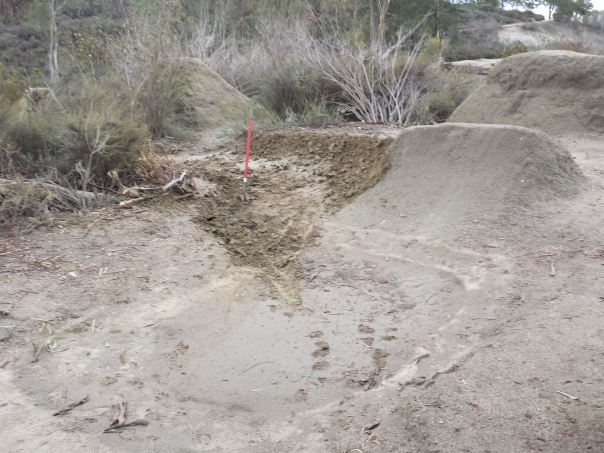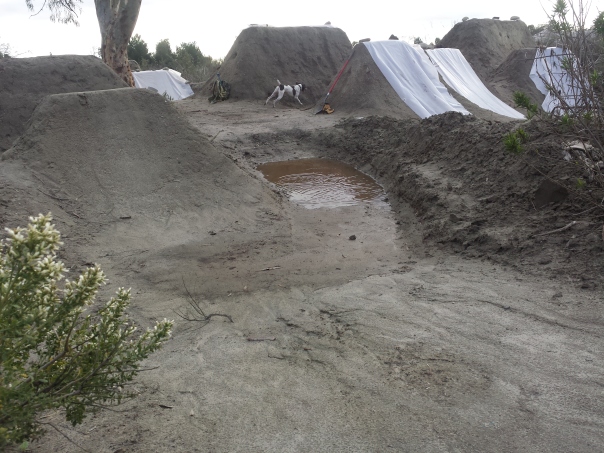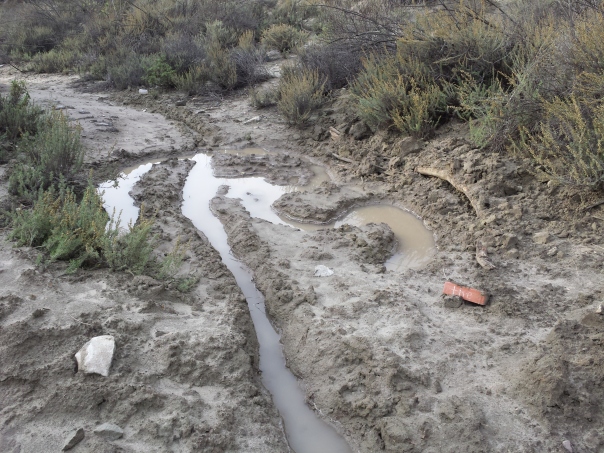Here in Southern California rain is a rare occurence, but when it does rain it often rains hard. This causes a whole range of flooding and erosion problems all across the region. These problems could be easily mitigated with the application of well designed earthworks and water management techniques. We can use permaculture earthworks to slow water down and spread it out across a large area, robbing it of its erosive energy while allowing it to passively soak into the soil where it can recharge aquifers and springs. With our culture’s current methods, we often have too much water when it rains, and not enough when it doesn’t
At the bike park, we have similar problems when it rains. The smooth surfaces so vital to a safe and exciting riding experience are quickly eroded by the force of rain drops hitting the ground. The shape of the lips and landings naturally funnels water into the low spots between jumps, making them unrideable until the puddle dries out. This leads to hours of rebuilding, resurfacing, and removing water after each rain storm. In the dry season, which can last for 10 months, the bike park is often a hot and dusty place with little shade. The more we dig and expose bare soil, the more the site dries out.
There is a saying in permaculture, “the problem is the solution.” With that mindset, I am taking a new look at how we manage water at the bike park. I have begun to re-shape the land to direct the rain, allowing it to passively flow into swales and infiltration basins, leaving the riding surface dry and allowing the water to soak into the soil. The water that is stored underground will be used to grow fast growing leguminous trees, which will eventually provide shade to the site. These same trees will fix nitrogen into the soil, while also providing a large amount of mulch to cover the bare soil, reducing evaporation. As a bonus, having trees interspersed with the jumps will also provide a more enjoyable riding experience.
Every element in a design, such as a tree, should have multiple functions. This is often called stacking functions, and ensures that the energy you put into implementing an element is returned many times over. Furthermore, no element stands completely alone. Each element interacts with the elements around it, and we can design to take advantage of beneficial relationships between elements, all within the context of nature’s inherent patterns. This is the essence of a successful permaculture design. The challenge lies in having the perspective to observe and predict what these relationships will be.
For now, I am starting small with the simple goal of directing rainwater off of the riding surfaces and into the soil. As I observe and keep my mind open to new perspectives, I will hopefully see how I can facilitate beneficial relationships between the many elements of the bike park site.

I’ve begun to dig infiltration basins that are below the grade of the riding surface. Here you can see the mud puddle left by the last rain, and the beginning of the basin that will collect the water from this part of the jumps.

I dug this infiltration basin before the last rain storm, and it appears to be working. The loose soil to the right of the basin will be planted with trees, which will utilize the water soaked into the soil.

This swale/basin demonstrates the permaculture principle of edge. By digging in lots of curves we can fit a very long trench into a small area, while also maximizing the edge between water and land. The edges between different environments are where nature is most diverse and abundant.
Reblogged this on World Organic News and commented:
Water-designed into the system
LikeLike